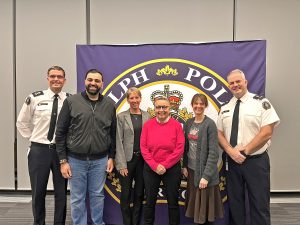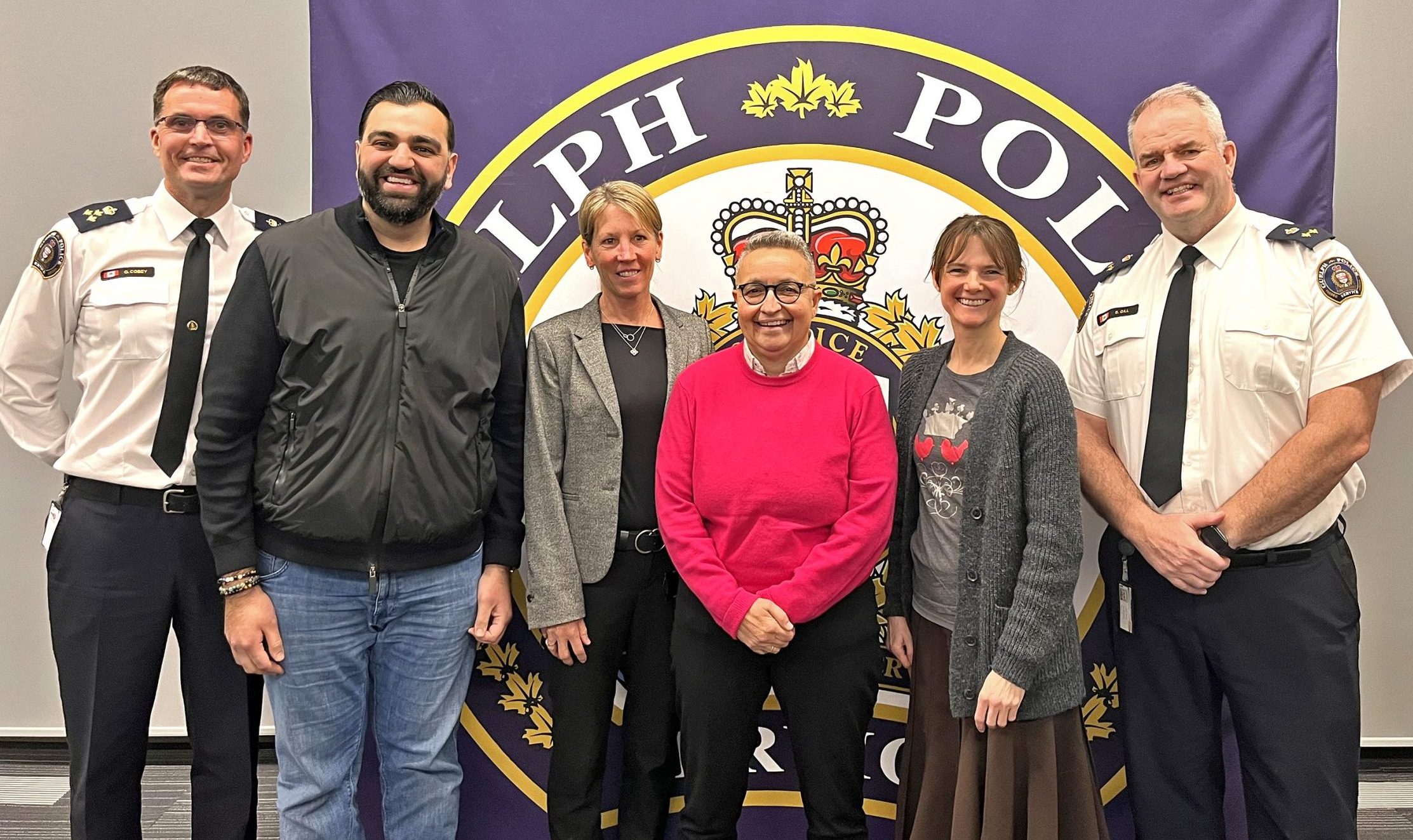GUELPH – In an information session hosted at Guelph Police Service headquarters on Jan. 20, Det. Sgt. James Graham and Cindy McMann from Guelph-Wellington Women in Crisis gave a lengthy presentation on sex trafficking.
“I think one thing we have to acknowledge [is that] human trafficking, intimate partner violence, it is not a developing issue,” said Guelph Police Chief Gordon Cobey in his opening statement.
“It is a very well-established, very well-rooted issue in our city.”
Cobey continued, “This is a priority for our city and our service. This is part of our strategic plan that will guide us for the next several years.
“This is also aligned with council’s unanimously passed motion, defining intimate partner violence an epidemic in our city.”
As the presentation began, McMann offered a “simple language” definition of human trafficking.
“So, when we’re talking about trafficking, we’re talking about traffickers really like manipulating or in some way forcing somebody into doing work,” said McMann.
“And then exploiting that person by taking most if not all of the money that person would make and then controlling that person and that person’s work environment, such that the person would find it difficult to impossible to leave.”
McMann said people can be trafficked into two streams: labour and/or sex work. However, in Canada sex work is most common.

From left: Guelph Police Services Chief Gord Cobey, vice chair Ajay Sharma, Det. staff Sgt. Melanie Clark, Guelph-Wellington Women in Crisis Executive Director Sly Castaldi, Cindy McMann and Guelph Police Services Deputy Chief Steve Gill pose for a photo at an information session at the Guelph Police headquarters. Photo by Ellouise Thompson
Myths
McMann and Graham debunked common myths surrounding sex trafficking and its victims.
“Maybe the most common myth that we see is this idea that if somebody is trafficked in Canada, that they have come from somewhere else,” said McMann.
“And if you were to be trafficked in Canada, you would be shipped across an international border somewhere … and it’s not that it never happens in Canada, but it’s really, really rare.
“Most people who are trafficked in Canada, they come from Canada, they stay in Canada where they will spend their whole lives,” said McMann.
Graham added, “90 or 91 per cent of people trafficked in Canada are Canadian.”
Another myth McMann pointed out is that if somebody is going to be trafficked, they will be trafficked by a stranger.
“That’s usually not true either,” she said. “Most people are trafficked by somebody who they know, by somebody they trust.
“This is very important to a trafficker because they are making money off of the work that other people do, so they really have to do a lot to build that bond of trust.”
Graham noted that 91% of those trafficked in Canada knew their trafficker.
Another myth is that all victims are held against their will using physical force such as “being chained inside a shipping container,” said McMann.
“Again, it’s not like that level of physical force and physical restraint never happens in Canada. But again, it’s super unlikely; that’s not how traffickers usually operate in Canada.”
Graham chimed in to add that not all sex traffickers are male.
“I think over the last decade, police-reported statistics have stated that 82% of traffickers are male, but that’s still 18% female,” said Graham.
However, he told the audience he believes many in that 18% could be on both sides, noting it is most likely these women were sex trafficked and have now taken to recruiting other girls as a “survival tactic” or to “give themselves a break from working”.
And finally, the last two myths included in the presentation were: all sex workers are being trafficked and those that are trafficked must have been living a risky lifestyle.
“Because somebody is engaging in sex work doesn’t automatically mean that they are [being] trafficked,” said McMann.
“The last thing that I come across quite a bit in my work is this idea that if somebody is trafficked that they were probably living a risky lifestyle, and that’s simply not true.”
McMann says anyone is at risk of being trafficked, and a trafficker will often search for a gap in a person’s life and try to fill it, building trust with an individual.
“We all have gaps in our lives,” said McMann.
Building trust
“What we see is this process of befriending or most commonly boyfriending, where a trafficker will introduce themselves to somebody and will either pretend to be a friend or pretend to be a romantic partner and get into a relationship with somebody and then traffic somebody out of that relationship,” said McMann.
“This process can take a couple of weeks, it could take a couple of months, it could take a year, it could take more than a year.”
Graham shared that 34% of those trafficked were trafficked by an intimate partner.
McMann said the easiest way for traffickers to start conversations with new potential victims is through the internet.
“When a trafficker is going to reach out and introduce themselves to people, the easiest way for them to do that is online,” said McMann.
She noted that despite what some may imagine when they think of a sex trafficker, these people are not “lurking and waiting in gross adult chat rooms that nobody ever goes to.”
Instead, they’re interacting with people on popular social media platforms such as TikTok, Facebook, Instagram, etc.
“If they’re aiming for a younger crowd, they are going to use gaming platforms,” said McMann. “They are very big into Fortnight right now; they’re big into Roblox.”
She added this behaviour is not exclusive to the online world, as traffickers will use the same tactic in person by attending high-volume events and areas to try and interact and meet new potential victims.
And in cases where it would be inappropriate for an adult to be, such as a school event or in the school during classes, McMann said it is not uncommon for traffickers to use somebody they already have control over to do their “recruiting.”
Graham said the most common way for traffickers to “recruit” locally is by using the boyfriend method.
“Unfortunately, the truth of it is they may not even realize they are being trafficked because they think the boyfriend cares for them,” said Graham.
“We [the police] look at them as a trafficker, they look at them as a boyfriend.”
Graham told the room many people aren’t aware they are being trafficked, which is by design.
He says the traffickers use manipulation in a slow and calculated way so the victim believes they are in a relationship that just went “a little off the rails,” but everything is fine.
Signs of trafficking
According to McMann, a few warning signs that somebody is being trafficked are a sudden influx of cash or luxury items and goods, an over-the-top “Hollywood style romantic relationship or friend group.”
For youth, warning signs could include no longer doing well in school, no longer caring about college or university, and other sudden changes in personality.
Graham added some traffickers will brand their victims with a tattoo.
“Some still like to brand; some brand in more private areas than others, but not all,” said Graham.
“They evolve overtime, so I think they’ve realized that branding a girl is a little bit obvious of what they are doing.”
Other warning signs for those further into the trafficking process could include: mental health issues skyrocketing, a complete change in lifestyle, anxiety, “scripted responses” to questions about how they are doing or where they are going, being extremely secretive and withdrawing from social activities.
The statistics
According to statistics from the Government of Canada presented by Graham, over the last 10 years 83% of human trafficking instances reported to police were in urban communities.
“This is all based on police reports, so we are the tip of the iceberg,” said Graham, referring to the many unreported and undocumented cases in the country.
Graham also said 93% of trafficking victims in Canada were women and girls, 24% were under 18 and 44% were aged 18 to 24. Meaning 70% of all women trafficked were under the age of 24.
Getting help
Those in need of help and support are encouraged to contact Victim Services Wellington at vswguelph.on.ca or 519-824-1212 ext. 7304 as well as call one of the non-emergency police phone lines at 519-824-1212 for Guelph Police or 1-888-310-1122 for the OPP.
For more information about sex trafficking contact Guelph-Wellington Women in Crisis at 519-836-5710 or visit gwwomenincrisis.org.




